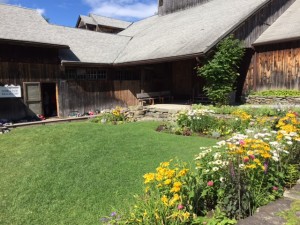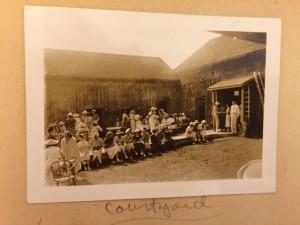Our first lucky break came when my old friend, F. Cowles Strickland, founding-director of the Berkshire Playhouse at Stockbridge, Massachusetts, began to drop in on our practice sessions. He asked many intelligent questions which I answered with words that the boys illustrated in movement, a process that gave Strick a double-edged idea. He took me aside one day, and suggested that the boys and I give a series of weekly lecture-demonstration-teas for the public; he was certain that many people, eager to learn about the technical and creative problems of dance, would pay to attend the sort of semi-social occasions he proposed. ~Ted Shawn
A month ago I had the pleasure and privilege of being a Research Fellow at Jacob’s Pillow Dance Festival, where I spent four glorious days in the Blake’s Barn archive searching through boxes of Ted Shawn’s past: diaries, letters, photographs, account books, drafts of lectures, mimeographs of newsletters from the early war years, and a copy of the first draft of the original manuscript of One Thousand and One Night Stands (a very different book from the one that was eventually edited by Gray Poole and published in 1960). My research objective had to do with looking for clues about the audience experience in the early, alpha years of the Festival (1933-1939).
Pretty quickly I became fixated on those famous “teas” that took place in the garden area just outside the barn-cum-performance space. At first Shawn was skeptical about the possibility of “any potential audience that would have to travel a rutted road to reach us.” He also worried that the dancers would balk at having to make and serve the tea and sandwiches, receive the guests, and park their cars before participating in the lecture-demonstrations at the center of the teas. But since the dancers were “willing and eager,” he recalled in the book draft, “we went out and bought thirty or forty dime store cups, saucers and spoons, and set the first Friday afternoon for this experiment . . . The boys made really delicious sandwiches in quantity and in interesting variety. We seated the people on benches, and chairs gathered from the house and from the cabins. They seemed pleased and went away having enjoyed an usual and interesting experience.” That first Friday tea brought in 45 people. The next week 75 came. And by the end of Jacob’s Pillow’s first summer of programming in late August 1933, “we performed for an audience of 200. People who couldn’t be seated crowded doorways, stood on sawhorses to peek in windows, but no one asked for his money back.”
As he admits in his autobiography, Shawn was motivated by the income the teas brought in (at a dollar a head, it was significant money in the midst of the Depression). But I’m guessing that the opportunity to grow his audience, not just in numbers but also in terms of dance knowledge and cultural awareness, was also appealing to this born teacher. His pedagogical instincts were first tested in 1915 at the Denishawn school in Los Angeles, where he and Ruth St. Denis launched the first fully-realized American institution for professional dance education. And they were fine-tuned at the Pillow, where Shawn’s teaching gifts led his audiences into previously undiscovered worlds. Here, for example, is a passage from the script of a curtain talk Shawn gave in August 1942 in order to prepare his audience for a performance by Asadata Dafora: “We feel this place, Jacob’s Pillow, in this University of the Dance, that it is more than just education activity; here is one of those small centers—here all nations, all people interested in the dance can and do work together in complete harmony. We have already had, in the first five years, people representatives of each race. We have this week four men born and raised in west Africa, in the district know as Sierra Leone, bringing to us the rhythms of Africa.”
The ethos of audience-centered liberal (that is, free) learning that Ted Shawn first established in the summer of 1933 continues to thrive in a variety of ways at the Pillow, from the “Seeing Dance, Talking Dance” questions prompts that are joyously posted on bulletin boards and bathroom stalls, to the Pillow Talks that precede the performances and the post-show discussions that cap them off, to the Norton Owen Reading Room at Blake’s Barn, where all visitors are warmly encouraged to explore the institutional history through books, videos, photographs, costume displays and archival materials. As Director of Preservation Norton Owen tells it, it’s impossible to separate the full Jacob’s Pillow experience from the discrete act of watching the dance performance itself. This is because the rich learning culture of the place infuses everything that happens on its lushly green, buggy, gloriously welcoming campus. But what Owen is also pointing to is the thoughtful, deliberate way in which Jacob’s Pillow Dance Festival organizes the audience experience as a guest experience in the real sense of the word (and not the phony corporate/Starbucks use of “guest”). This surely has to do with the legacy of those early lecture-demonstration teas. And it also surely has to do with the quality of the staff, including Artistic and Executive Director Ella Baff, Mr. Owen, resident scholars Maura Keefe and Nancy Wozny, an impressive roster of college-age interns, and of course the teachers and performers who have been flowing through Pillow summers since 1933.
NB: During my visit in mid-August, the staff, students and performers were grieving the impending loss of Ella Baff, who was set to leave at the end of the season to take on the newly created position of Senior Program Officer in the Arts and Cultural Heritage program at the A.W. Mellon Foundation on October 1. While it is certainly a loss for Jacob’s Pillow, it’s a real gain for our national arts culture. Ella will do important and good work at Mellon.



[…] Ted, Tea and Arts Talk Our first lucky break came when my old friend, F. Cowles Strickland, founding-director of the Berkshire Playhouse at Stockbridge, Massachusetts, began to drop in on our practice sessions. He asked many intelligent questions which I… … read more AJBlog: We The AudiencePublished 2015-09-13 […]